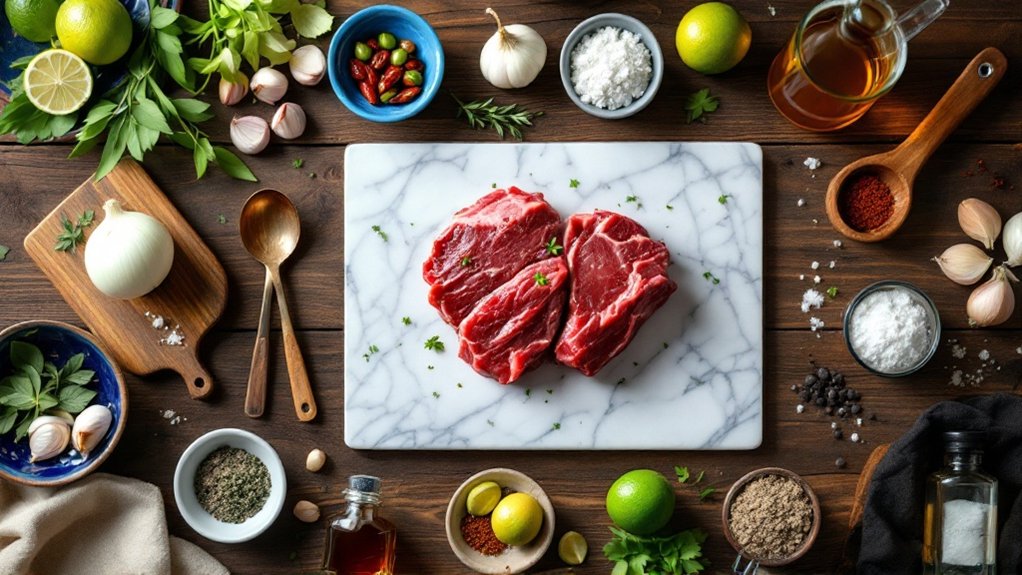
You might be surprised to learn that barbacoa, a treasured Mexican dish, traditionally involves slow-cooking meat in underground pits lined with agave leaves. Today’s version brings this ancient technique into your modern kitchen, transforming humble beef cheeks into melt-in-your-mouth tenderness while keeping things light with crisp jicama “tortillas.” Let’s explore how this innovative spin on a classic dish marries tradition with fresh, contemporary flair.
Since we’re diving into a mouthwatering beef cheek barbacoa recipe, let’s paint a picture of what you’ll create.
You’ll transform tough beef cheeks into tender, succulent meat that practically melts in your mouth, wrapped in crisp jicama “tortillas” that offer a fresh, low-carb twist on the traditional dish.
When you’re done, you’ll have a beautiful plate featuring richly-colored, braised meat with a glistening sauce, topped with bright green cilantro and a drizzle of white crema.
The contrast of textures and colors will make your guests’ eyes light up before they even take their first bite.
It’s a dish that brings together classic Mexican flavors with modern presentation.
History
While barbacoa’s origins can be traced back to the indigenous peoples of Mexico, today’s beef cheek variation emerged from the cattle-ranching culture of Northern Mexico and South Texas.
You’ll find that the traditional method involved wrapping meat in maguey leaves and slow-cooking it in underground pits, a technique that’s been passed down through generations of families gathering for weekend celebrations.
As you explore barbacoa’s evolution, you’ll discover how Mexican vaqueros transformed this dish, adapting it to include beef cheeks – a cut they found both flavorful and economical.
When you make this dish today, you’re not just preparing a meal; you’re participating in a culinary tradition that spans centuries, connecting you to the resourceful spirit of those who came before.
Recipe

Beef cheek barbacoa is a traditional Mexican dish known for its rich, tender meat that practically melts in your mouth after hours of slow cooking. The meat comes from the facial muscles of cattle, which develop intense marbling and flavor from constant use, making it perfect for long, slow-cooking methods.
This recipe transforms tough beef cheeks into succulent, flavorful meat through a combination of aromatic spices, citrus, and patient cooking. The resulting barbacoa can be served in tacos, burritos, or over rice, and the meat stays moist and flavorful even when reheated.
- 4 lbs beef cheeks, trimmed
- 4 chipotle peppers in adobo sauce
- 1 white onion, quartered
- 6 garlic cloves
- 2 tablespoons ground cumin
- 2 tablespoons dried oregano
- 3 bay leaves
- 2 limes, juiced
- 2 tablespoons apple cider vinegar
- 2 cups beef broth
- Salt and black pepper to taste
Trim excess fat from the beef cheeks and season generously with salt and pepper. Blend chipotles, onion, garlic, cumin, oregano, lime juice, and vinegar into a smooth paste.
Place beef cheeks in a slow cooker, pour the marinade over them, add bay leaves and beef broth. Cook on low for 8-10 hours until the meat easily shreds with a fork. Remove the bay leaves, shred the meat, and mix it with the cooking liquid.
For best results, let the meat marinate in the spice blend overnight before cooking. If beef cheeks are unavailable, chuck roast or brisket can be substituted, though cooking times may vary.
To reduce fat content, refrigerate the finished dish and skim off the solidified fat layer before reheating. For a healthier version, serve with cauliflower rice instead of tortillas and use low-sodium beef broth.
Final Thoughts
Though preparing beef cheek barbacoa requires patience and dedication, the end result delivers a deeply satisfying experience that’ll transport you straight to the heart of Mexican cuisine.
As you gather your loved ones around the table, you’ll witness their eyes light up at the sight of tender, aromatic meat that practically melts in your mouth.
Don’t be surprised if this dish becomes a cherished part of your family’s culinary traditions, sparking conversations and creating memories that’ll last for years to come.
While the cooking process might seem daunting at first, you’ll find that each step builds your confidence and deepens your appreciation for slow-cooked comfort food.


